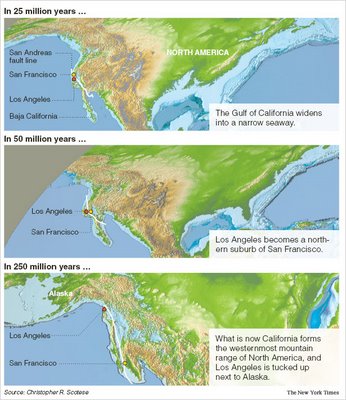 The New York Times (their Science section is on a roll!) has a very good piece on geologists who are predicting the direction of continental drift over the next 200-300 million years. Their conclusion is that the continents will slam back together into another big supercontinent that they call Pangea Ultima.
The New York Times (their Science section is on a roll!) has a very good piece on geologists who are predicting the direction of continental drift over the next 200-300 million years. Their conclusion is that the continents will slam back together into another big supercontinent that they call Pangea Ultima.I've pasted in their projections for western North America above. They believe that 250 million years from now, due to slippage along the San Andreas Fault, the site of the city of Los Angeles will have moved north past San Francisco to about the latitude of Alaska. I wonder what that will do to rush hour traffic on the 405?
Lots of interesting stuff. RTWT!
1 comment:
There was a great demonstration model of tectonics in a British documentary a few years ago. To model the collision of the Indian subcontinent with the Eurasian plate, they poured a pot of golden syrup into a tub of the stuff, making a thick rippled bow wave representing ... the Himalayan range. One of those demonstrations that beats years of classroom learning.
Post a Comment